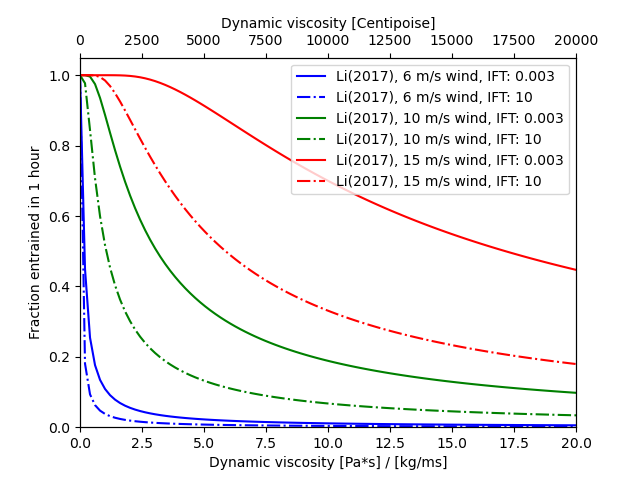Note
Go to the end to download the full example code.
Oil entrainment rate
import numpy as np
import matplotlib.pyplot as plt
from opendrift.models.physics_methods import oil_wave_entrainment_rate_li2017
Viscosities from 0 to 20 Pa*s / kg/ms
vis = np.linspace(0, 20, 100)
colors = ['b', 'g', 'r']
lstyles = ['-', '-.']
Calculating and plotting the entrainment rate as function of viscosity for 3 wind speeds
fig, ax = plt.subplots()
for wind, color in zip([6, 10, 15], colors):
# Entrainment rate from Li (2017)
for ift, ls in zip([.003, 10], lstyles):
r = oil_wave_entrainment_rate_li2017(
dynamic_viscosity=vis, oil_density=950, interfacial_tension=ift,
wind_speed=wind)
# from instantaneous rate (s-1) we calculate the probability of entrainment within one hour:
p1h = 1-np.exp(-3600*r)
ax.plot(vis, p1h, color+ls, label='Li(2017), %s m/s wind, IFT: %s' % (wind, ift))
plt.legend()
ax.set_xlim(vis.min(), vis.max())
ax.set_ylim(0, 1.05)
# Make second x-axis showing viscosity in Centipoise
ax2 = ax.twiny()
x1, x2 = ax.get_xlim()
ax2.set_xlim(1000*x1, 1000*x2)
ax2.figure.canvas.draw()
ax2.set_xlabel('Dynamic viscosity [Centipoise]')
ax.set_ylabel('Fraction entrained in 1 hour')
ax.set_xlabel('Dynamic viscosity [Pa*s] / [kg/ms]')
plt.show()

Total running time of the script: (0 minutes 0.745 seconds)